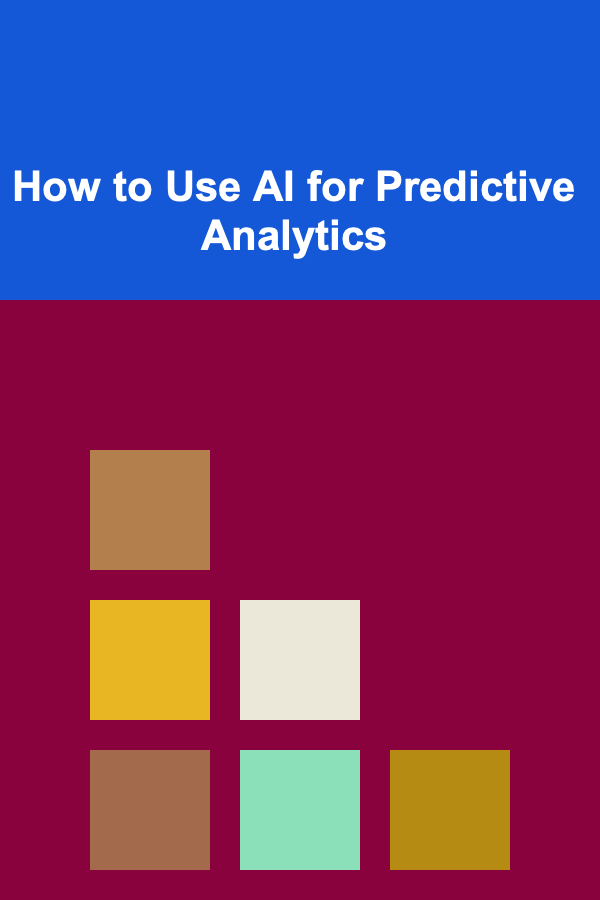
How to Use AI for Predictive Analytics
ebook include PDF & Audio bundle (Micro Guide)
$12.99$7.99
Limited Time Offer! Order within the next:

In recent years, Artificial Intelligence (AI) has become an integral part of many industries, revolutionizing how businesses operate, make decisions, and engage with customers. One of the most powerful applications of AI is predictive analytics, which allows organizations to forecast future trends, behaviors, and events based on historical data. By leveraging AI for predictive analytics, companies can make data-driven decisions that enhance performance, improve customer satisfaction, and streamline operations.
This article explores how AI can be used for predictive analytics, the different types of predictive models, how to implement them, and real-world applications of predictive analytics across various industries. Additionally, it examines the challenges organizations may face when adopting AI for predictive analytics and best practices to ensure successful outcomes.
Understanding Predictive Analytics
Predictive analytics involves using historical data, statistical algorithms, and machine learning techniques to identify the likelihood of future outcomes. This type of analysis goes beyond simple descriptive statistics by making predictions about future events based on patterns identified in past data. Predictive analytics is widely used in industries such as finance, healthcare, marketing, retail, and more.
The ultimate goal of predictive analytics is to answer specific business questions, such as:
- What is likely to happen in the future?
- How can we prepare for future trends or events?
- What actions should be taken to maximize benefits or minimize risks?
In the past, businesses relied on traditional statistical methods to make predictions, but the complexity of data and the vast amounts of information now available have made AI a critical component of predictive analytics. AI, particularly machine learning (ML) and deep learning (DL), enhances the accuracy and efficiency of predictive models, enabling organizations to uncover hidden insights in massive datasets.
The Role of AI in Predictive Analytics
Artificial intelligence plays a central role in predictive analytics by automating data analysis and enabling the identification of patterns that would otherwise go unnoticed. AI allows predictive models to evolve and improve over time, providing more accurate forecasts and recommendations. Here are the key ways in which AI contributes to predictive analytics:
1. Data Processing and Feature Selection
AI algorithms excel at processing large volumes of data. Predictive models require vast amounts of historical data to identify trends and generate accurate predictions. AI tools can automatically clean, preprocess, and organize this data, removing inconsistencies and outliers. Additionally, AI can identify the most important features (variables) in the dataset that have the greatest impact on the target variable, enabling more effective predictions.
2. Machine Learning and Model Training
Machine learning, a subset of AI, is at the heart of predictive analytics. ML algorithms learn from historical data, continuously improving their predictions as new data is introduced. These models are trained on labeled datasets, where the outcome (e.g., a sale, customer churn, etc.) is known. The model "learns" the relationship between the input features and the output, and it can then make predictions on new, unseen data. Some common machine learning algorithms used in predictive analytics include:
- Linear Regression: Predicts a continuous outcome based on input variables.
- Logistic Regression: Used for binary classification tasks (e.g., yes/no, pass/fail).
- Decision Trees: Breaks down data into a tree-like structure, useful for classification and regression tasks.
- Random Forests: An ensemble method that combines multiple decision trees to improve accuracy.
- Support Vector Machines (SVM): Classifies data by finding the hyperplane that best separates classes.
- Neural Networks: Mimic the human brain to recognize complex patterns in data, especially in deep learning applications.
3. Deep Learning for Complex Predictions
Deep learning, a more advanced subset of machine learning, is used when the data is highly complex, such as in image recognition, natural language processing, or time-series forecasting. Deep neural networks (DNN) consist of multiple layers of interconnected nodes that work together to process data. By utilizing deep learning techniques, AI can predict outcomes in scenarios where traditional models may struggle, such as detecting fraud or identifying patterns in large, unstructured datasets.
4. Real-Time Predictions
AI-powered predictive models can provide real-time insights by continuously analyzing data as it is generated. In industries like e-commerce or finance, where rapid decision-making is critical, real-time predictions can help businesses respond to customer behavior, market trends, or financial risks almost instantly. By integrating AI with live data streams, organizations can proactively adjust strategies, optimize operations, and enhance customer experiences in real-time.
5. Forecasting and Scenario Analysis
AI-based predictive models can be used for forecasting, which involves predicting future events or trends. AI can analyze historical data and identify cyclical patterns, seasonality, and trends to forecast demand, sales, inventory levels, and more. Furthermore, AI can be used to run scenario analyses, where various future scenarios are modeled based on different assumptions, helping businesses prepare for uncertainty.
Implementing AI for Predictive Analytics
Successfully integrating AI into predictive analytics requires a well-defined process that includes data preparation, model selection, training, and deployment. Here are the key steps to implement AI for predictive analytics:
1. Define Business Objectives
Before implementing AI for predictive analytics, organizations must clearly define their business objectives. Understanding the problem that needs to be solved is critical to determining which predictive model to use. For example, a retailer may want to predict customer churn, while a financial institution may be interested in forecasting loan defaults.
2. Collect and Prepare Data
Data is the foundation of predictive analytics, and AI requires high-quality, clean data to generate accurate predictions. Organizations should gather relevant historical data from internal and external sources, such as customer behavior, market conditions, and operational data. Data preprocessing steps, such as data cleaning, normalization, and feature engineering, are crucial to ensure the quality and relevance of the data.
3. Choose the Right Predictive Model
Once the data is prepared, businesses need to select the appropriate predictive model. The choice of model depends on the nature of the problem, the type of data available, and the desired outcomes. Machine learning algorithms such as regression models, decision trees, and random forests are common for predicting numerical or categorical outcomes, while deep learning techniques may be used for more complex tasks such as image or speech recognition.
4. Train the Model
Training the model involves feeding historical data into the algorithm and allowing it to learn the relationships between input features and output predictions. This process often requires dividing the data into training and testing sets to evaluate the model's performance. Overfitting, where the model performs well on the training data but poorly on unseen data, must be avoided. Techniques such as cross-validation and regularization can help prevent overfitting.
5. Deploy and Monitor the Model
After the model is trained and validated, it can be deployed in a production environment where it will make real-time predictions. Continuous monitoring is essential to ensure that the model continues to perform well as new data is introduced. AI models can degrade over time due to changes in data patterns, so periodic retraining may be necessary to maintain accuracy.
Real-World Applications of Predictive Analytics Using AI
AI-powered predictive analytics is transforming industries across the globe. Here are some examples of how organizations are leveraging AI for predictive analytics:
1. Healthcare: Predicting Disease Outbreaks and Patient Outcomes
In healthcare, predictive analytics can be used to forecast disease outbreaks, predict patient outcomes, and optimize resource allocation. For instance, AI models can analyze patient data to predict the likelihood of readmission to a hospital or the risk of developing chronic conditions like diabetes. Predictive models can also help identify potential disease outbreaks by analyzing patterns in patient records, climate data, and population movement.
2. Retail: Personalized Recommendations and Inventory Forecasting
Retailers use AI for predictive analytics to personalize product recommendations for customers and optimize inventory levels. By analyzing customer purchasing behavior, browsing history, and demographic data, AI can predict which products a customer is most likely to purchase. Additionally, predictive models help retailers forecast demand, ensuring they have the right products in stock and minimizing overstocking or stockouts.
3. Finance: Fraud Detection and Credit Scoring
In the financial sector, predictive analytics is used to detect fraudulent transactions, assess creditworthiness, and predict loan defaults. AI algorithms can analyze patterns in transaction data to identify unusual behavior and flag potential fraud. Additionally, predictive models can assess the likelihood that a customer will default on a loan based on their financial history, behavior, and external economic factors.
4. Manufacturing: Predictive Maintenance and Supply Chain Optimization
In manufacturing, AI-powered predictive analytics can optimize production processes, improve supply chain management, and predict equipment failures. By monitoring data from sensors on machines, AI can predict when a piece of equipment is likely to fail, allowing for maintenance to be performed before costly breakdowns occur. Similarly, predictive models can help optimize inventory management, ensuring that the right materials are available at the right time.
5. Marketing: Customer Segmentation and Campaign Effectiveness
Marketers use AI to predict customer behavior, optimize advertising spend, and improve customer targeting. AI algorithms can segment customers based on their likelihood to convert, enabling more personalized marketing efforts. Predictive models can also forecast the success of marketing campaigns, helping businesses allocate resources more efficiently and adjust strategies to maximize ROI.
Challenges and Considerations
While AI for predictive analytics offers significant benefits, there are challenges that organizations must overcome:
1. Data Quality and Availability
The quality of the predictions depends on the quality of the data used. Poor-quality or incomplete data can lead to inaccurate models and predictions. Ensuring that data is accurate, consistent, and up-to-date is critical to the success of predictive analytics.
2. Model Interpretability
Some AI models, especially deep learning models, can be seen as "black boxes" because it is difficult to understand how they arrive at specific predictions. In certain industries, such as healthcare and finance, model interpretability is crucial to ensure transparency and trust in the results. Organizations may need to balance the complexity of the model with the need for interpretability.
3. Ethical and Bias Concerns
AI models can inadvertently perpetuate bias if the data used to train them is biased. For example, predictive models in hiring or lending may favor certain groups over others if historical data reflects societal biases. It is important to carefully evaluate AI models to ensure they are fair and do not discriminate against specific groups.
4. Integration with Existing Systems
Integrating AI-powered predictive analytics into existing systems can be challenging, especially for organizations with legacy infrastructure. Ensuring that the AI model works seamlessly with current business processes and technology is essential for achieving the desired outcomes.
Conclusion
AI-driven predictive analytics is a game-changer for businesses looking to stay ahead in an increasingly data-driven world. By leveraging AI to predict future trends and outcomes, organizations can make informed decisions, optimize operations, and improve customer experiences. While there are challenges to implementing AI for predictive analytics, the benefits---ranging from better decision-making to enhanced profitability---are clear. With the right tools, data, and expertise, businesses can harness the power of AI to predict the future and stay competitive in their respective industries.

How to Keep Your Home's Electrical System Safe and Well-Maintained
Read More
How to Save Money on Landscaping and Home Gardening
Read MoreHow to Set Up an Essential Oil Journal for Tracking Uses
Read More
How to Use a Cash Envelope System to Control Spending
Read More
Navigating the Digital Shift in Libraries: Tools and Techniques for a 21st Century Librarian
Read More
How To Leverage Social Media for Remote Job Searching
Read MoreOther Products

How to Keep Your Home's Electrical System Safe and Well-Maintained
Read More
How to Save Money on Landscaping and Home Gardening
Read MoreHow to Set Up an Essential Oil Journal for Tracking Uses
Read More
How to Use a Cash Envelope System to Control Spending
Read More
Navigating the Digital Shift in Libraries: Tools and Techniques for a 21st Century Librarian
Read More